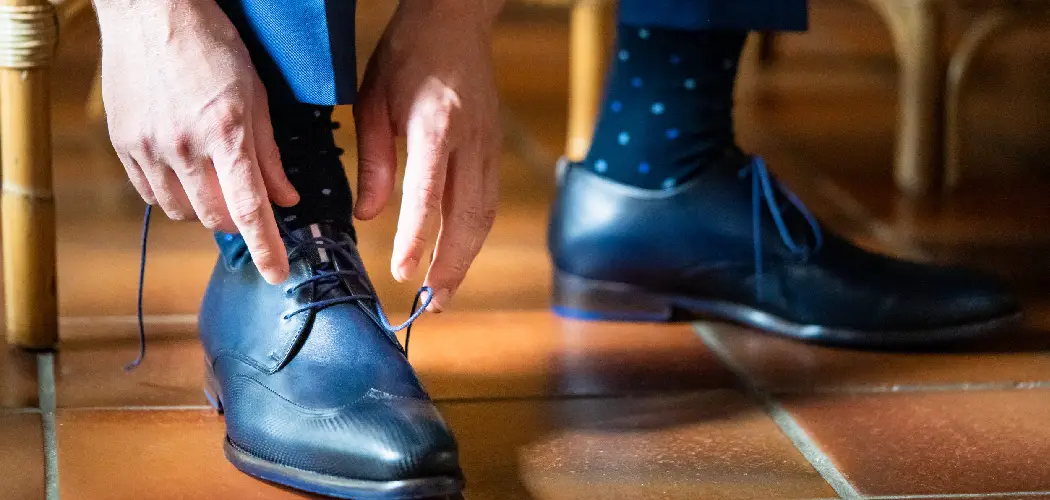Leather shoes have long been celebrated for their unmatched elegance and durability, blending timeless style and enduring quality. Despite their many virtues, leather footwear is prone to developing unsightly creases, which can mar their appearance and reduce their lifespan. These creases form due to the leather’s natural flexibility reacting to the movements of the wearer’s feet.
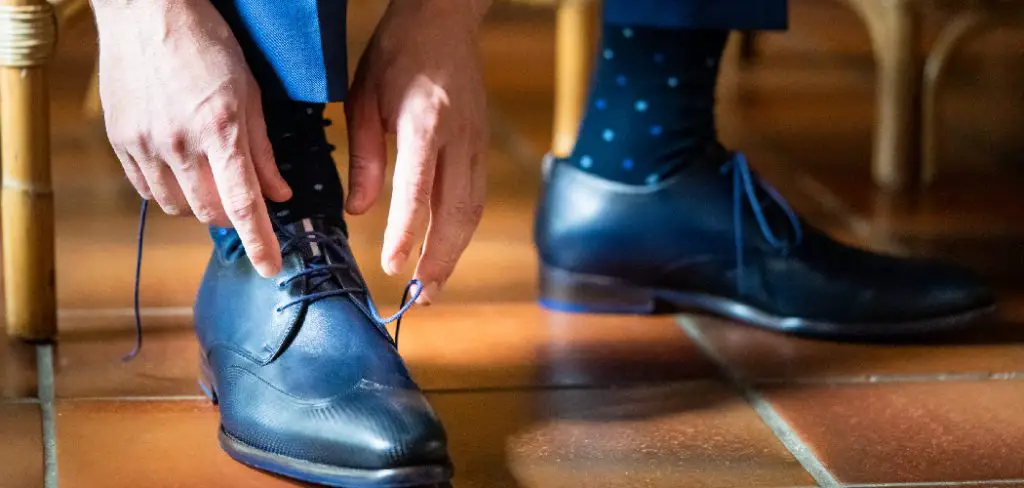
This guide aims to enlighten shoe enthusiasts on how to reduce creases in leather shoes, preserving their pristine condition and aesthetic appeal. By employing specific care techniques and preventative measures, it is possible to significantly minimize the occurrence of creases. This introduction serves as a gateway to understanding the essential steps required to maintain the beauty and integrity of leather shoes, highlighting the importance of quality selection, proper use, and meticulous care in combating the common creasing issue.
Choose Quality Leather
When starting your quest for crease-resistant leather shoes, the pivotal first step is opting for high-quality leather. High-quality leather not only enhances the aesthetic appeal but also plays a crucial role in the durability and longevity of the shoes.
A. Select Full-Grain Leather
Choosing shoes made from full-grain leather is key for minimizing creasing. Full-grain leather, recognized for its breathability and strength, is the highest quality of leather available. This type of leather includes the entire grain layer, offering a level of durability and resistance to creasing that lower grades of leather simply cannot match. Full-grain leather tends to develop a patina over time, enhancing its beauty without compromising the structure or creating unsightly creases.
B. Avoid Thin or Poor-Quality Leather
Thin or poor-quality leather is significantly more prone to creasing and wear. These leathers often undergo extensive processing to disguise imperfections, weakening their structure and leading to premature creasing. To ensure longevity and maintain a pristine appearance, it’s essential to steer clear of shoes crafted from these inferior materials.
C. Invest in Well-Constructed Shoes
The shoe’s construction is just as important as the quality of the leather. Well-constructed shoes are designed with proper reinforcement and structure to support the leather and prevent excessive flexing and folding, which are the primary causes of creases. Features such as sturdy soles, reinforced heel counters, and robust shanks all contribute to a shoe’s ability to retain its shape and resist creasing. Investing in well-constructed shoes may come at a higher initial cost, but the durability and appearance retention payoff make it a wise choice for the discerning buyer.
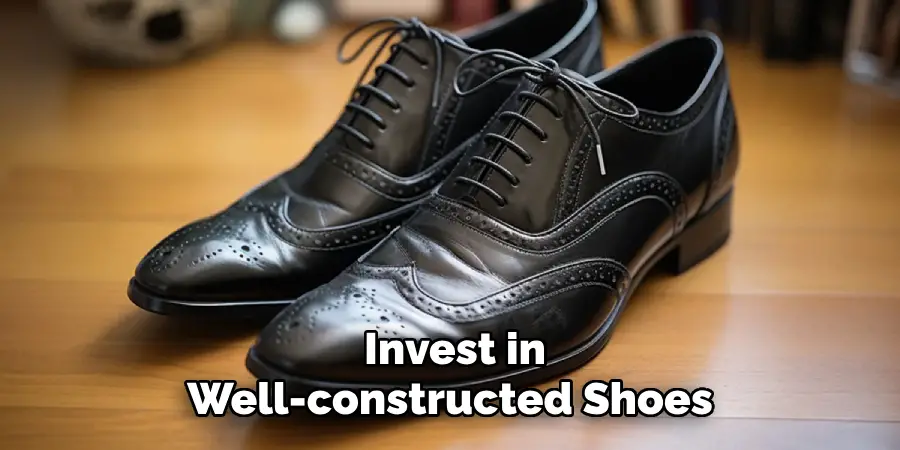
How to Reduce Creases in Leather Shoes: Use Shoe Trees
Using shoe trees is a fundamental step in preserving the form and minimizing creases in leather shoes. These simple devices, often overlooked, play a critical role in maintaining the shape and integrity of your footwear when not in use.
A. Insert Shoe Trees When Not Wearing
The most effective time to use shoe trees is immediately after removing your shoes. Inserting cedar shoe trees helps to absorb moisture and maintain the shape of the leather, thereby reducing the formation of creasing. The natural properties of cedar wood not only help in absorbing moisture but also deodorize the shoes, keeping them fresh.
B. Choose the Correct Size and Shape
For shoe trees to be effective, they must fit properly and match the shape of your shoes. Shoe trees come in various sizes and shapes, and selecting the right one is crucial for providing the support needed to prevent creases. A correctly fitting shoe tree will smooth out creases by stretching the leather gently and maintaining the shoe’s original shape.
C. Regular Use
The key to maximizing the benefits of shoe trees lies in their consistent use. Make it a habit to insert shoe trees into your leather shoes as soon as you remove them. This practice not only aids increase prevention but also extends the shoes’ lifespan by keeping them in their proper shape. Regular use of shoe trees is an investment in the longevity and appearance of your leather footwear.
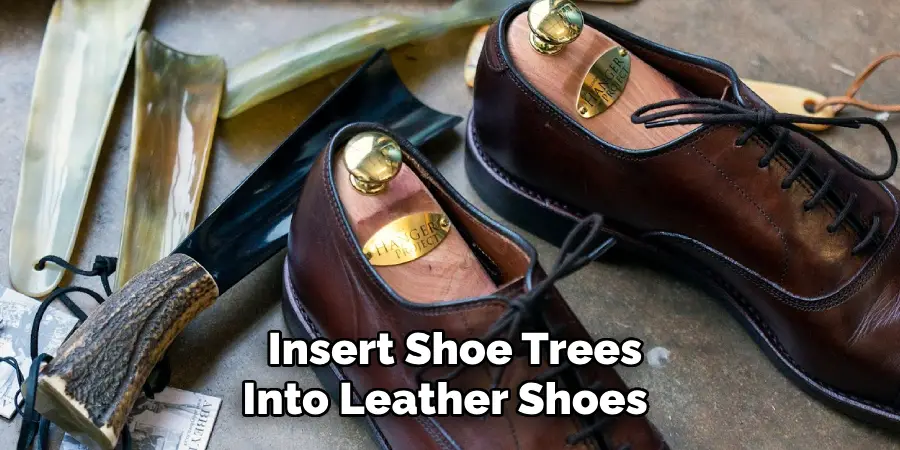
How to Reduce Creases in Leather Shoes: Proper Shoe Care
Proper shoe care is integral to prolonging leather shoes’ life and minimizing creases’ appearance. This entails a routine of cleaning, conditioning, polishing, and protecting the leather, as well as being mindful of how often the shoes are worn.
A. Clean and Condition Regularly
The preservation of leather shoes begins with regular cleaning and conditioning. Start by gently removing any dirt or dust from the surface of the shoes with a soft cloth or a brush designed for leather care. Apply a quality leather cleaner in a circular motion, ensuring the removal of built-up grime without damaging the leather.
Refining the leather is crucial to maintain its suppleness and resilience following cleaning. Apply a quality leather conditioner evenly to prevent the leather from drying out or cracking. Allow the conditioner to penetrate the leather before buffing it to a soft shine. This practice keeps the leather hydrated, making it less prone to creasing.
B. Polish and Protect
Beyond cleaning and conditioning, regular shoe polish or cream application plays a vital role in nourishing the leather and creating a protective barrier. Choose a polish or cream that matches the color of your leather shoes to enhance their appearance while providing essential moisture. Polishing not only restores the shoes’ luster but also offers protection against moisture and environmental damage such as UV rays and dirt.
After applying polish, allow it to dry before buffing the shoes with a soft brush or cloth to achieve a radiant shine. For added protection, consider using a water-repellent spray designed for leather, offering an extra layer of defense against the elements.
C. Avoid Excessive Wear
An often overlooked aspect of leather shoe care is the importance of rotation. Wearing the same pair of leather shoes daily accelerates the creasing process and wear and tear. Instead, rotate your leather shoes, allowing them at least a full day to rest and recover between wears.
This rest period enables the shoes to air out and the leather to relax, consequently minimizing creasing and extending the lifespan of the footwear. Investing in several quality pairs of leather shoes ensures style variety and contributes significantly to maintaining each pair’s condition over time.
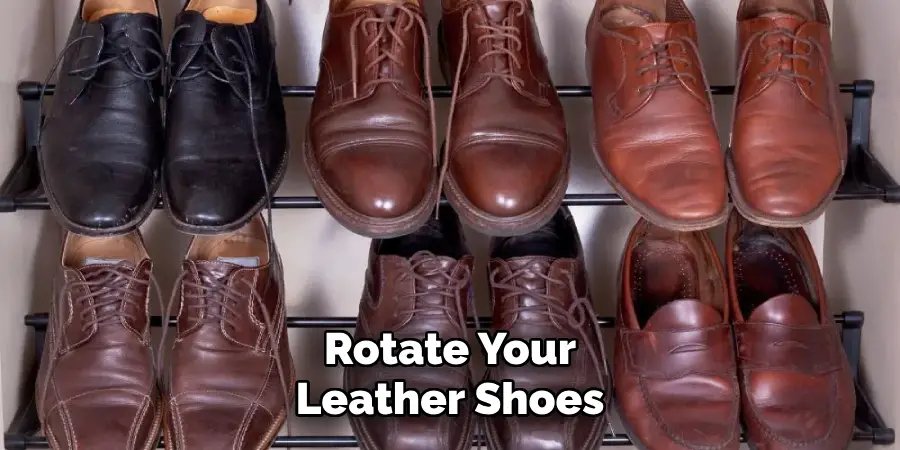
Implementing these proper shoe care practices will significantly contribute to your leather shoes’ longevity and aesthetic appeal. Regular cleaning, conditioning, polishing, and rotation are essential steps in avoiding excessive creases and maintaining the shoes’ structural integrity and comfort.
Wear Correctly
How one wears leather shoes can significantly impact their durability and appearance, especially when preventing creases. Paying attention to how you put on, lace, and even walk in your shoes can make a substantial difference in maintaining their pristine condition.
A. Use a Shoehorn
The shoehorn is one of the simplest yet most effective tools for leather shoe care. Using a shoehorn when putting on your leather shoes helps prevent excessive stress on the heel counter, a common area for wear and tear. By supporting the shoe’s structure as your foot slides in, the shoehorn reduces the likelihood of creasing and damage to the heel, ensuring the back of the shoe remains intact and comfortable.
B. Proper Lacing
Lacing your shoes correctly is not just about aesthetics; it plays a crucial role in the shoe’s fit and how pressure is distributed across the foot. Tight, even lacing ensures a secure fit, reducing movement inside the shoe that can lead to creases. Additionally, proper lacing minimizes the strain on the leather when walking, as it allows the shoe to flex naturally without warping or folding excessively. This balance of snugness and comfort is key to extending the life of leather shoes and keeping them looking their best.
C. Maintain Good Posture and Walking Technique
How you walk and carry yourself also profoundly affects the longevity and appearance of your leather shoes. Walking confidently and maintaining good posture ensures a more natural footfall, reducing excessive bending and folding of the leather. Avoiding dragging your feet or taking uneven steps minimizes the stress on specific shoe areas, thus preventing localized creasing. By adopting a proper walking technique, you’re caring for your shoes and promoting better overall body health.
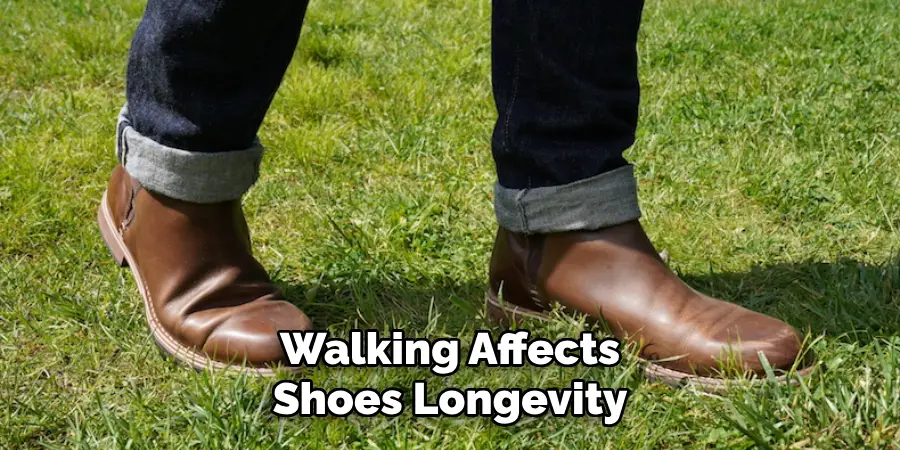
Adhering to these practices for wearing leather shoes correctly is paramount for anyone looking to invest in quality footwear. Not only does it contribute to the comfort and elegance of your stride, but it also plays a crucial role in preserving the aesthetic appeal and structure of the shoes over time.
Store Properly
Properly storing leather shoes is crucial for maintaining their shape, appearance, and longevity. How and where you store your footwear can significantly affect their condition over time. Adhering to these guidelines will ensure your leather shoes remain pristine and ready for your next wear.
A. Use Shoe Bags or Dust Covers
Leather shoes should be stored in shoe bags or dust covers when not worn. This precaution helps to protect them from dust, sunlight, and other environmental factors that could degrade the leather. Sun exposure, for example, can fade the color and dry out the leather, making it more prone to cracking. Dust and dirt can settle into the creases of the shoes, causing them to wear out faster. By using shoe bags or dust covers, you can significantly reduce these risks and keep your shoes looking newer for longer.
B. Avoid Overcrowding
Storing shoes in an overcrowded space or packing them together tightly can lead to creases and deformation. Leather shoes need breathing room to maintain their shape and prevent unwanted pressure points that can cause creasing. Ensure there is enough space in your storage area so that shoes are not pressed against each other. Use a shoe rack or separate shelves for each pair to avoid direct contact if possible. This will keep your shoes in optimal condition and make it easier to find and select the right pair when you need them.
C. Maintain Ideal Conditions
The environment where you store your leather shoes can profoundly impact their condition. Leather shoes should be stored in a cool, dry place with proper ventilation to prevent issues such as mold, mildew, and excessive moisture. High humidity can soften and warp the leather, while insufficient air circulation can encourage the growth of mold and mildew. Use a dehumidifier in the storage area to maintain an ideal humidity level. Additionally, avoid storing shoes near heaters or in direct sunlight, as excessive heat can dry out and crack the leather.
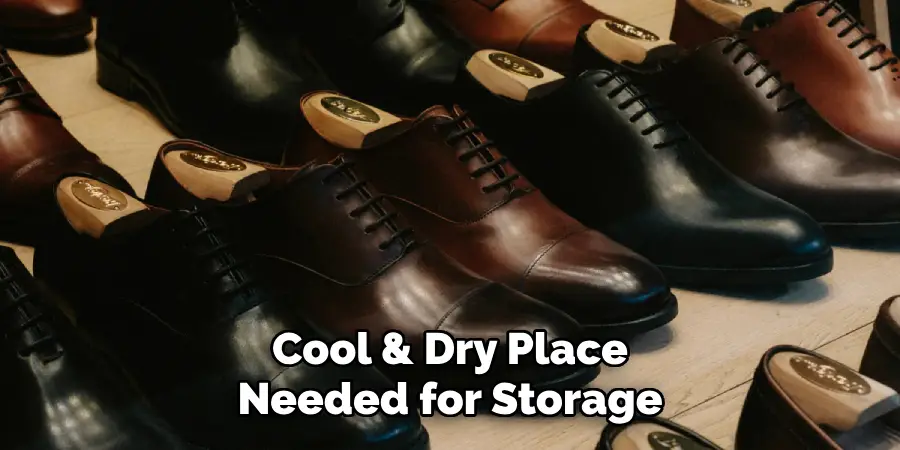
Following these storage practices is essential for preserving the quality and extending the life of your leather shoes. By using shoe bags or dust covers, avoiding overcrowded spaces, and maintaining ideal conditions, you can protect your investment and enjoy your leather footwear for many years to come.
Address Existing Creases
Even with diligent care, leather shoes can develop creases over time due to natural wear and pressure points. However, several methods can address and minimize the appearance of these creases, ensuring your footwear maintains its elegance and longevity.
A. Use Leather Conditioner
One of the initial steps in addressing creases is to apply a small amount of leather conditioner to the affected areas. Leather conditioner helps to moisturize the leather, restoring its natural flexibility and making it easier to work with. Gently massage the conditioner into the creased areas using a soft cloth in circular motions. This process can help soften the leather and smooth out creases, improving the overall appearance of the shoes. Choosing a conditioner appropriate for the type of leather of your shoes is essential to avoid damaging them.
B. Use a Shoe Stretcher
For deeper or more stubborn creases, consider using a shoe stretcher. A shoe stretcher can gently stretch the leather, providing relief to creased areas and helping to minimize their appearance. When using a shoe stretcher, it’s important to proceed cautiously and not overstretch the leather, as this could potentially damage your shoes.
Insert the stretcher into the shoe and adjust it until a slight tension is felt. Leaving the stretcher in the shoe for a few hours or overnight may help relax and smooth out the creased leather. This method can be particularly effective in combination with the application of a leather conditioner.
C. Professional Restoration
If creases are persistent and deeply set, consulting with a professional shoe repair specialist may be the best course of action. A professional has the tools, experience, and expertise to effectively address and restore creased leather shoes. They can assess the extent of the creases and recommend the most appropriate restoration techniques, which may include steaming, reshaping, and conditioning the leather. Professional restoration is especially recommended for high-value or vintage leather shoes, ensuring that any intervention is done with the utmost care to preserve the shoes’ integrity and appearance.
By adopting these techniques, you can address existing creases in your leather shoes and maintain their beauty and functional longevity. Whether through at-home care or professional intervention, it’s possible to rejuvenate creased leather shoes and extend their lifespan significantly.
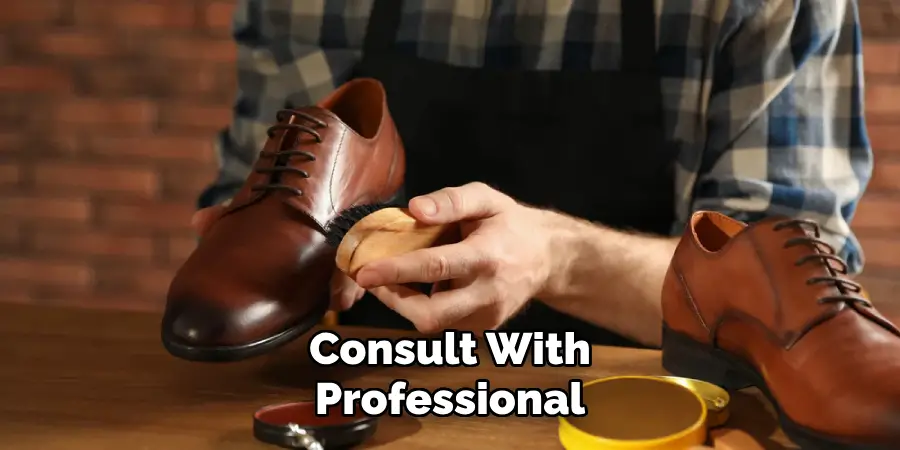
Frequently Asked Questions (FAQs) about Leather Shoe Care
Q1: How Often Should I Condition My Leather Shoes?
A1: It’s recommended that you condition your leather shoes every 3 to 6 months, depending on their frequency of use and exposure to harsh conditions. Regular conditioning helps maintain the leather’s moisture balance, preventing it from drying out and cracking.
Q2: Can I Use Household Items to Clean My Leather Shoes?
A2: While certain household items can be used for cleaning leather shoes, it’s important to do so with caution. Mild solutions like a mixture of water and gentle soap can be used for basic cleaning. However, it’s best to use products specifically designed for leather care to avoid potential damage.
Q3: Is It Necessary to Use a Shoe Stretcher for All Types of Leather Shoes?
A3: Using a shoe stretcher is not necessary for all types of leather shoes but can be helpful for breaking in new shoes or adjusting shoes that have become uncomfortable over time. If your shoes fit well and are comfortable, there’s no need to use a stretcher.
Q4: What Is the Best Way to Dry Wet Leather Shoes?
A4: If your leather shoes get wet, the best approach is to dry them naturally at room temperature, away from direct heat sources like radiators or sunlight. Stuffing them with newspaper or a shoe tree can help maintain their shape and absorb moisture more effectively. Avoid using a hairdryer or other artificial heat sources, as these can cause the leather to dry out and crack.
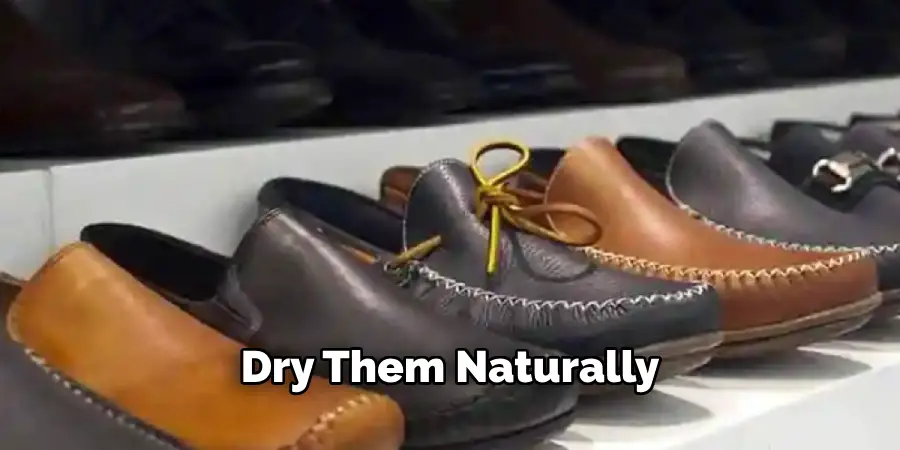
Conclusion
In summary, this guide has outlined essential techniques for preventing and reducing creases in leather shoes, emphasizing the importance of proper care, the use of shoe trees, correct wearing habits, and meticulous storage practices. Consistent maintenance and attention to detail are vital in preserving the appearance and extending the longevity of your leather footwear.
By adopting a holistic approach towards care—ranging from how to reduce creases in leather shoes to understanding the significance of environmental conditions—we can ensure that our cherished pairs remain in pristine condition. It is through the implementation of these effective strategies that one can maintain the beauty, comfort, and integrity of leather shoes for many years to come. Therefore, the wearer is encouraged to integrate these maintenance practices into their routine, safeguarding their investment and enjoying the timeless elegance of crease-free leather shoes.

